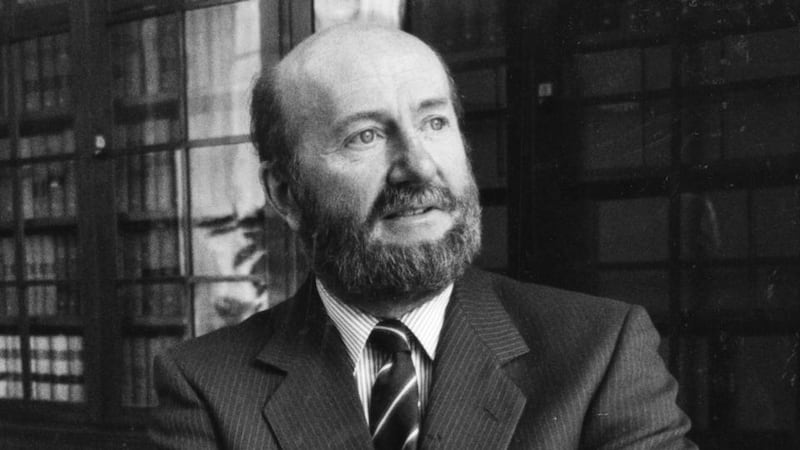More than half of the attorneys general who have served since the foundation of the State were subsequently appointed judges in the superior courts.
Sixteen of the 29 attorneys general were appointed judges, beginning with the first one, Hugh Kennedy, who was appointed chief justice immediately after completing a two-year term as attorney general between 1922 and 1924.
All but six of the next 21 attorneys general were subsequently appointed to either the High Court, the Supreme Court, or in one instance, the European Court of Justice.
The tradition of attorneys general moving from the job to the bench was well established until the 1990s.
Kennedy’s successor, John O’Byrne, became a High Court judge in 1926, as did the first Fianna Fáil attorney general, Conor Maguire, who was appointed president of the High Court. James Geoghegan, also a Fianna Fáil TD, was appointed to the Supreme Court in 1932, as were Cearbhall Ó Dálaigh in 1953, Cecil Lavery in 1950, and Anthony Hederman in 1981.
Those appointed to the High Court after serving as attorney general were: Kevin Haugh (1942); Kevin Dixon (1946); Charles Casey (1951); Thomas Teevan (1954); Aindreas Ó Caoimh (1954); Declan Costello (1977); and Harry Whelehan (1994).
John Murray was appointed to the European Court of Justice while Máire Whelan has been appointed to the Court of Appeal.
FF and FG
A not-insignificant minority of attorneys general were either serving Fianna Fáil or Fine Gael TDs at the time of their appointment, but that tradition was more apparent in the earlier decades of the State. A sitting Fine Gael TD, the late John Kelly, briefly served as attorney general in 1977, following the appointment of Declan Costello as a High Court judge.
Conor Maguire, Cearbhall Ó Dálaigh and John Murray each became chief justice subsequent to their appointments as judges.
While most of the attorneys general appointed to the bench were elevated when the term of the government of which they were members came to an end, eight of them were appointed when vacancies arose in the courts.

These included Harry Whelehan, the attorney general for the 1992-1994 Fianna Fáil-Labour coalition. He was appointed as president of the High Court by then taoiseach Albert Reynolds in 1994 amid vehement opposition from the Labour side. In the light of major public controversy over the attorney general’s office’s handling of an extradition case involving a paedophile priest, Brendan Smyth, Whelehan resigned from the High Court position only two days after his appointment.
This controversy seemed to break the tradition of immediate elevation to the superior courts for outgoing attorneys general. Since then, there have been seven attorneys general, but only one, Whelan, has been appointed a judge after leaving the office.
Return to Bar
Four of the seven – Eoghan Fitzsimons, Dermot Gleeson, the late Rory Brady and Paul Gallagher – returned to the Bar. Another, David Byrne, was appointed an EU commissioner in 1999. He was the second attorney general to follow that route; Peter Sutherland became an EU commissioner in 1985.

Michael McDowell was elected to the Dáil in 2002 immediately after having served as attorney general and became minister for justice.
According to an authoritative legal source, it is likely most attorneys general would have been appointed judges if they had wished.
“If the likes of Dermot Gleeson, Rory Brady or Paul Gallagher had wanted to become judges, there would have been no impediment to their appointment,” the source said. “Constitutionally you cannot take away from the Executive the right to appoint judges who are eligible.
“Who you put in the Supreme Court is important [from a political perspective]. If you appoint a liberal or conservative, you know what you are doing. That is innately political.”
Some of the early attorneys general were offered judicial positions but rejected them. Patrick Lynch, who was attorney general in the 1930s, turned down a High Court appointment reputedly because of Civil War executions.
John A Costello was the Cumann na nGaedhal attorney general for six years from 1926 until 1932. He subsequently became a Fine Gael TD and, later, was elected taoiseach, leading two inter-party governments beginning in 1948.

The youngest attorney general was John Rogers, who was appointed at the age of 34 in 1983. A Labour Party appointment, he was a close friend of Labour leader Dick Spring. Until then a junior barrister, he became a senior counsel on the day of his appointment. He returned to practise as a barrister in 1987 after a change of government.
Patrick Connolly was attorney general during a Fianna Fáil government led by Charles Haughey between 1981 and 1982. He resigned after it emerged in August 1982 that Malcolm Macarthur, later convicted for murder, was staying as a guest in Connolly’s home in Dalkey.












